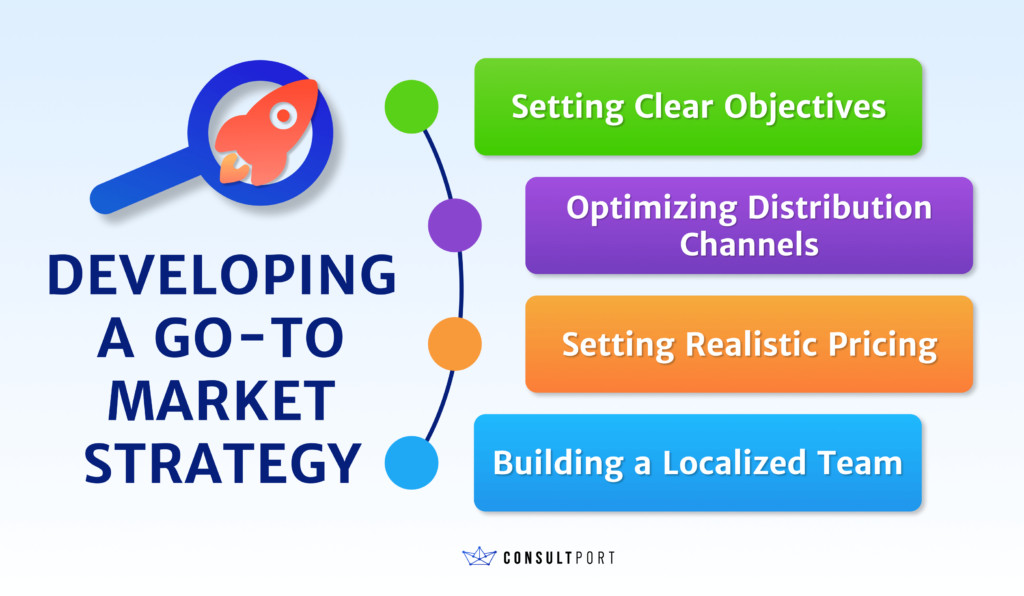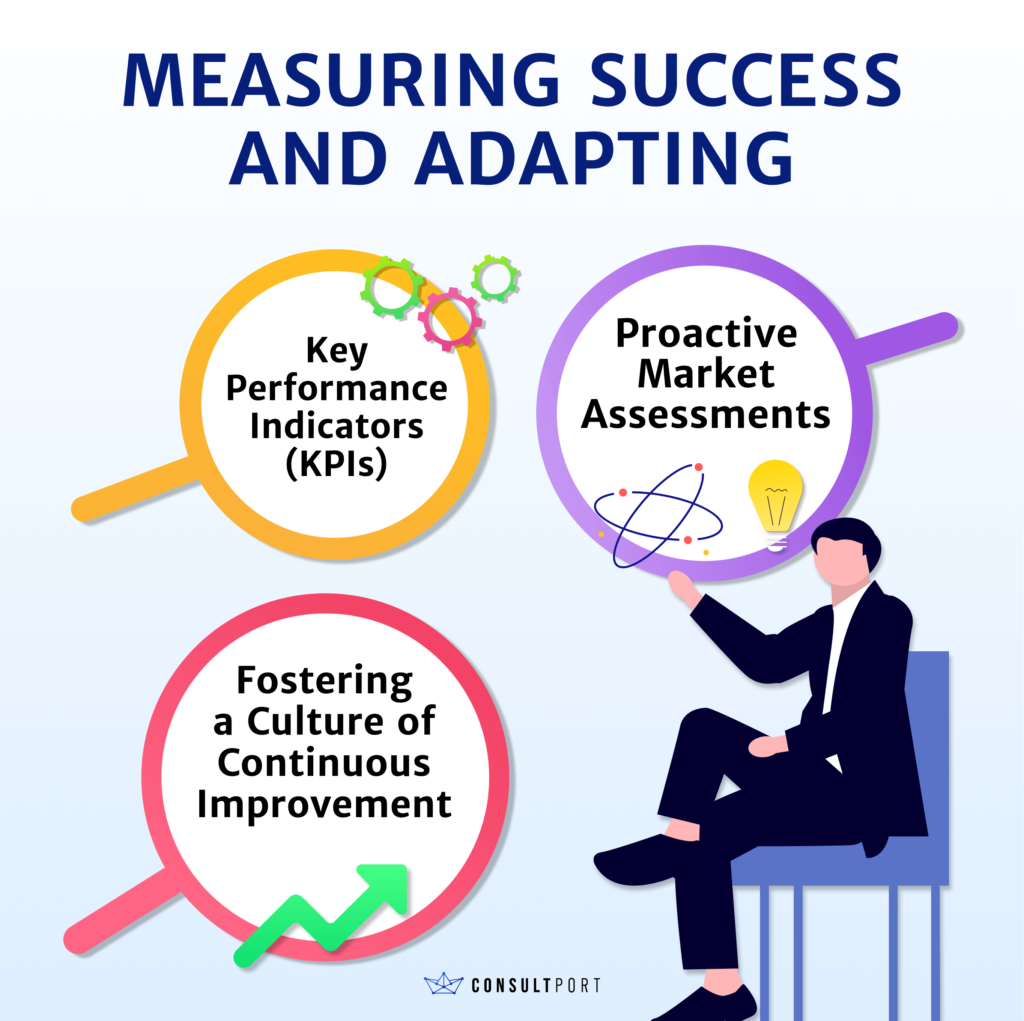Global Expansion Begins With An Effective Market Entry Strategy
Blog Categories:
Published:
January 7, 2024
Reading Time:
6 minutes

The quest for growth and global expansion remains a constant pursuit in global business as companies seek to extend their reach into new markets. In this context, the significance of a well-crafted market entry strategy cannot be overstated.
In this article, we delve into the essence of market entry strategy, exploring the intricacies involved in developing a robust go-to-market plan, understanding the key metrics for measuring success, and making necessary adaptations.

Understanding Market Dynamics: Embarking on a journey to enter a new market is akin to setting sail into uncharted waters. It demands careful consideration, meticulous planning, and a comprehensive understanding of the target market.
One fundamental aspect of this strategy is market research. In a globalized world, where markets are diverse and dynamic, understanding the nuances of the target market is paramount.
Emerhub, a leading business consultancy, emphasizes the importance of choosing the right market entry strategy for emerging markets. Their insights highlight the need for a tailored approach, considering factors such as the regulatory environment, cultural nuances, and local competition. A one-size-fits-all approach is rarely effective, and success often hinges on adapting strategies to the specific conditions of the target market.
Tailoring Entry Modes to Company Capabilities: In the quest for a successful market entry, businesses must also assess their own capabilities and resources. This self-awareness is crucial in determining the feasibility of the chosen strategy.
Whether it’s exporting, franchising, licensing, joint ventures, or establishing wholly-owned subsidiaries, the selection of the most appropriate entry mode should align with the company’s strengths, objectives, and risk tolerance.
RocketBlocks, a platform known for its comprehensive insights into market entry cases, underscores the need for a clear value proposition. This entails not only understanding what the company brings to the market but also how it differentiates itself from existing players. A well-defined value proposition not only attracts customers but also aids in building a sustainable competitive advantage.
Transitioning from the conceptualization of a market entry strategy to its execution requires a step-by-step approach. This brings us to the next crucial phase in the process – developing a go-to-market strategy.
In this article, we delve into the essence of market entry strategy, exploring the intricacies involved in developing a robust go-to-market plan, understanding the key metrics for measuring success, and making necessary adaptations.
The Essence of Market Entry Strategy

Understanding Market Dynamics: Embarking on a journey to enter a new market is akin to setting sail into uncharted waters. It demands careful consideration, meticulous planning, and a comprehensive understanding of the target market.
One fundamental aspect of this strategy is market research. In a globalized world, where markets are diverse and dynamic, understanding the nuances of the target market is paramount.
Emerhub, a leading business consultancy, emphasizes the importance of choosing the right market entry strategy for emerging markets. Their insights highlight the need for a tailored approach, considering factors such as the regulatory environment, cultural nuances, and local competition. A one-size-fits-all approach is rarely effective, and success often hinges on adapting strategies to the specific conditions of the target market.
Tailoring Entry Modes to Company Capabilities: In the quest for a successful market entry, businesses must also assess their own capabilities and resources. This self-awareness is crucial in determining the feasibility of the chosen strategy.
Whether it’s exporting, franchising, licensing, joint ventures, or establishing wholly-owned subsidiaries, the selection of the most appropriate entry mode should align with the company’s strengths, objectives, and risk tolerance.
RocketBlocks, a platform known for its comprehensive insights into market entry cases, underscores the need for a clear value proposition. This entails not only understanding what the company brings to the market but also how it differentiates itself from existing players. A well-defined value proposition not only attracts customers but also aids in building a sustainable competitive advantage.
Transitioning from the conceptualization of a market entry strategy to its execution requires a step-by-step approach. This brings us to the next crucial phase in the process – developing a go-to-market strategy.
KEY TAKEAWAYS
- Adaptability and Self-awareness: Companies are advised to assess their own capabilities and align entry modes with strengths, objectives, and risk tolerance. The need for adaptability is emphasized, stressing the importance of crafting strategies that can flexibly respond to changing market conditions.
Developing a Go-to-Market Strategy

Setting Clear Objectives: Crafting a robust market entry strategy is a significant task, but its success hinges on an equally well-thought-out go-to-market plan. One of the initial steps in this phase is setting clear objectives. Businesses must define what success looks like in the new market and establish measurable goals. These objectives could range from market share acquisition and revenue targets to brand recognition and customer engagement metrics.
Optimizing Distribution Channels: Moreover, the choice of distribution channels plays a pivotal role in the success of a go-to-market strategy. Whether it’s leveraging existing partnerships, establishing new collaborations, or adopting an online distribution model, aligning the distribution strategy with the target market’s preferences is crucial. The emergence of e-commerce and digital platforms has further expanded the possibilities, allowing businesses to explore innovative channels for reaching their audience.
Setting Realistic Pricing: In tandem with distribution, pricing strategies require careful consideration. Cultural perceptions of value, income levels, and competitive landscapes all influence the pricing dynamics in a new market. A pricing strategy that strikes the right balance between competitiveness and profitability is essential for gaining a foothold in the market.
Building a Localized Team: As businesses navigate the complexities of a new market, building a strong local team emerges as a critical success factor. This team serves as the bridge between the company and the local community, helping to navigate cultural nuances, understand customer preferences, and respond swiftly to market dynamics. The investment in a capable and culturally attuned team pays dividends in the form of accelerated market penetration and sustained growth.
In the context of developing a go-to-market strategy, establishing a seamless connection between the different elements – from setting objectives to building a local team – is essential. This ensures that each aspect is not viewed in isolation but rather as an integral component of a comprehensive strategy.
Measuring Success and Adapting

The execution of a market entry strategy and go-to-market plan is not the end of the journey but rather the beginning of an ongoing process. Measuring success and making adaptive changes based on real-time feedback and evolving market conditions is imperative for sustained growth and competitiveness.
Key performance indicators (KPIs): KPIs serve as the compass for measuring success. These metrics can span a wide range, including market share, revenue growth, customer acquisition costs, customer lifetime value, and brand awareness.
The choice of KPIs should align with the objectives set during the development of the go-to-market strategy. Regular monitoring of these indicators provides insights into the effectiveness of the strategy and highlights areas that may require adjustment.
Proactive Market Assessments: Adaptability is a cornerstone of successful market entry, and the ability to pivot in response to changing circumstances, consumer trends, or competitive landscapes is a hallmark of resilient businesses. This flexibility extends to all facets of the market entry strategy, from marketing campaigns to product offerings and distribution channels.
It is important to conduct regular market assessments to stay ahead of the curve. This involves staying attuned to market trends, monitoring competitor activities, and gathering customer feedback. A proactive approach to market intelligence allows businesses to anticipate shifts in consumer preferences and make strategic adjustments before challenges escalate.
Fostering a Culture of Continuous Improvement: Creating this culture includes not only adapting external strategies but also optimizing internal processes based on lessons learned during the market entry phase. Regular debriefs, post-implementation reviews and collaborative brainstorming sessions contribute to a culture that embraces change and thrives on innovation.
Crafting an effective market entry strategy is not a linear process but a dynamic and multifaceted journey. The essence lies in the meticulous planning that precedes execution, the thoughtful execution of a go-to-market strategy, and the continuous adaptation based on real-time feedback and evolving market conditions.
An Invaluable Partner
Consultport and its extensive network of experts is a reliable partner for companies seeking to craft a successful market entry strategy. With a deep pool of seasoned professionals spanning diverse industries, Consultport offers unparalleled expertise tailored to the unique needs of each client. The platform ensures access to specialists well-versed in the intricacies of market research, entry modes, go-to-market strategies, and adaptability measures.
This network of experts brings a wealth of experience, having successfully navigated the complexities of global expansion in various markets. Consultport's commitment to precision, innovation, and client success positions it as a strategic partner in formulating and executing market entry strategies.
Whether your business aims to enter emerging markets or establish a foothold in established ones, contact Consultport to help make informed decisions, mitigate risks, and seize opportunities for sustainable growth in a dynamic global landscape.
This network of experts brings a wealth of experience, having successfully navigated the complexities of global expansion in various markets. Consultport's commitment to precision, innovation, and client success positions it as a strategic partner in formulating and executing market entry strategies.
Whether your business aims to enter emerging markets or establish a foothold in established ones, contact Consultport to help make informed decisions, mitigate risks, and seize opportunities for sustainable growth in a dynamic global landscape.
Share This Story, Choose Your Platform!



